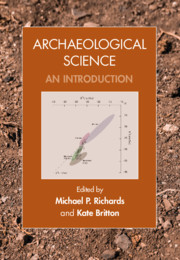Book contents
- Archaeological Science
- Archaeological Science
- Copyright page
- Contents
- Figures
- Tables
- Contributors
- Acknowledgements
- Part I Introduction
- Part II Biomolecular Archaeology
- 2 Ancient DNA
- 3 Proteomics
- 4 Residue Analysis
- 5 Isotope Analysis for Mobility and Climate Studies
- 6 Isotope Analysis for Diet Studies
- Part III Bioarchaeology
- Part IV Environmental Archaeology
- Part V Materials Analysis
- Part VI Absolute Dating Methods
- Index
- References
5 - Isotope Analysis for Mobility and Climate Studies
from Part II - Biomolecular Archaeology
Published online by Cambridge University Press: 19 December 2019
- Archaeological Science
- Archaeological Science
- Copyright page
- Contents
- Figures
- Tables
- Contributors
- Acknowledgements
- Part I Introduction
- Part II Biomolecular Archaeology
- 2 Ancient DNA
- 3 Proteomics
- 4 Residue Analysis
- 5 Isotope Analysis for Mobility and Climate Studies
- 6 Isotope Analysis for Diet Studies
- Part III Bioarchaeology
- Part IV Environmental Archaeology
- Part V Materials Analysis
- Part VI Absolute Dating Methods
- Index
- References
Summary
Isotope studies in archaeology are often concerned with the analysis of preserved proteins for the reconstruction of past diets, but isotopic signatures in the mineral phase of archaeological skeletons can also be used to reconstruct place of residence and even the contemporary local climate. These applications are based upon the premise of a relationship between underlying local geology/local soils (strontium) and ingested water (oxygen) to the body isotope chemistry of the individuals in question (see reviews in Bentley 2006, and Pederzani and Britton 2019). Where the distribution of isotope signatures within and across different ecosystems varies predictably, these methods can be used to source human and animal remains to specific regions or to identify non-local outliers or migrants (e.g., Bentley 2013; Müldner et al. 2009).
- Type
- Chapter
- Information
- Archaeological ScienceAn Introduction, pp. 99 - 124Publisher: Cambridge University PressPrint publication year: 2020
References
- 8
- Cited by



